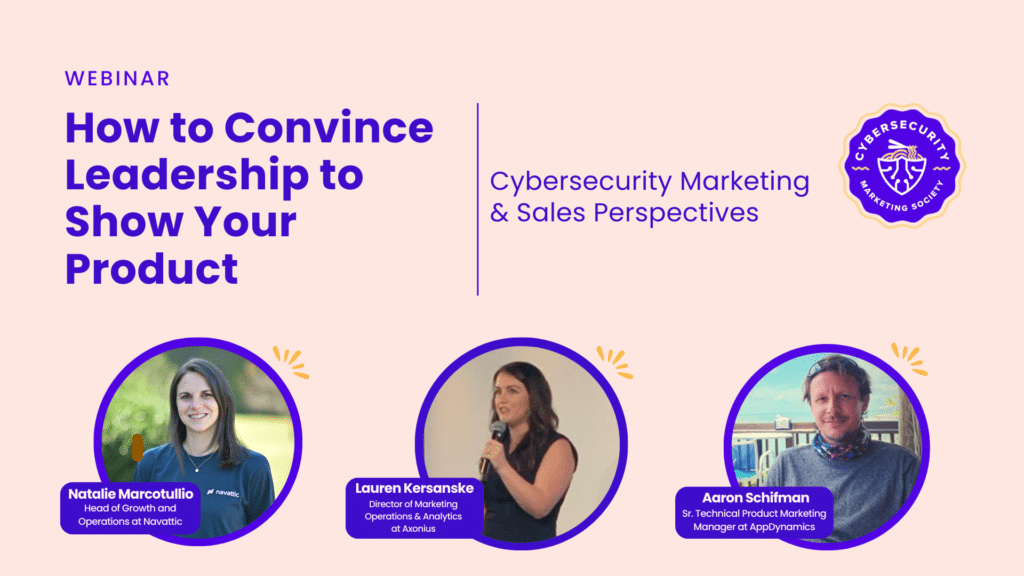
It’s 2024. Your competition will be able to see your product whether you purposefully show it off or try to keep it hidden away. However, your prospects and potential customers won’t work so hard—and being too secretive with your product could be losing you deals.
In fact, many security and IT buyers are averse to jumping into the sales funnel until they’ve determined the value themselves through seeing—or using—the product first. Interactive product demos, walk-through videos, and even full PLG plays enable the customer journey for these discerning buyers—and even channel partners.
Convincing your leadership team to take a more transparent approach can be challenging, especially in a field as cautious as cybersecurity. Our webinar aims to answer the big question, “How do you convince leadership to show your product?” with insights from expert marketers:
- Aaron Schifman, Senior Technical Product Marketing Manager at Cisco AppDynamics
- Lauren Kersanske, Director of Global Campaigns at Axonius
- Natalie Marcotullio, Head of Growth and Operations at Navattic
In this webinar, sponsored by Navattic, we explore the diverse perspectives of cybersecurity marketers who were able to convince leadership to start showing off more of their products via interactive demos. Watch the full webinar and check out the recap below!
The Changing B2B Buying Journey
The B2B buying process isn’t what it used to be. Today’s cybersecurity prospects are more savvy and better informed, often researching for months before engaging with sales. According to a Gartner study, nearly 77% of B2B buyers say their latest purchase was complex or difficult. This means potential buyers are likely arriving at your site seeking detailed information, not just a high-level benefits statement or sales pitch. Interactive demos are perfect for this as they let prospects explore your product on their own, which can speed up the sales process and increase conversions.
As Lauren Kersanske points out, by the time prospects arrive on your site, “they’ve already been researching for 1-3 months. They know what their problem is and they mostly understand what they’re trying to solve.” She adds that by the time they get to your site, they’re ready for product-focused content like interactive demos, that meet them where they are in their buying journey without a sales-heavy process.
This approach can be especially helpful for marketing teams and organizations who are shifting away from a “gate everything” mentality. In this clip, Natalie Marcotullio discusses the benefits of gating further down the user’s self-guided research journey:
How to Get Internal Buy-in
In cybersecurity, it’s important to show your prospects what sets you apart from your competition, but always remember that you control what’s shown in the interactive demo. You can highlight the best features without giving away the farm!
Experiencing Resistance
Lauren mentioned how Axonius leadership initially questioned if the effort was worth it compared to traditional videos.

Aaron Schifman has great advice for those who are experiencing the same issue.
In the end, traditional videos are easy to make, but they aren’t very engaging and can have a short shelf life. Interactive demos let customers explore the product themselves, see how it works in real-time, and understand its value better.
Showcasing ROI and Building Internal Champions
Having an interactive demo is great, but it’s also important that your leadership sees the potential return on investment (ROI). You can facilitate that by providing concrete data. For example, building champions starts by knowing your audience (yes, your stakeholder audience!). Lauren found that sharing data in the right way was integral to building champions internally at Axonius.
Lauren shared, “for the marketing team, sharing that interactive demos improved our onsite conversion rate-to-demo by x%, was really exciting!” What gets sales excited she says, is “qualitative data, like great feedback from prospects and partners.” This kind of data can showcase the power and impact your interactive demo is bringing.
Working with Sales
Like leadership, working hand in hand with your sales team can be a game-changer. Sales teams interact directly with prospects and quickly see the value of tools that make their job easier. Aaron Schifman stressed the importance of strategically aligning with sales leaders to create internal champions, noting that sales is typically “closest to the people who are going to be using the products,” and are often quick to see the value in tools that make their job easier, . Your champions can be helpful in advocating for the initiative within the organization, helping to persuade leadership to support the move to interactive demos. Their support can also be crucial in highlighting the practical benefits of the tool, and gaining the buy-in needed to implement it successfully.
Versatile Use Cases: Interactive Demos for the Show Floor or for Partner Enablement!
Interactive demos aren’t just for websites; they’re versatile and can be used in various scenarios.
Interactive Demos at the Booth
For example, at RSA, Axonius used interactive demos to manage booth traffic and engage attendees more effectively. Customizing demos for specific events or use cases can provide tailored experiences that resonate more deeply with different audiences.
Interactive Demos for Partner Enablement
Interactive demos are useful for partner enablement, as partners often have limited access to demo environments. As Aaron explains in the clip above, interactive demos provide a controlled way to showcase your products. That opens the door to more consistent messaging and understanding, making it easier for partners to present your product over your competitors’ because you’re making it easy for them.
Finding the Balance Between Features and Value
Finding a balance can help you avoid the common pitfall of overwhelming prospects with too many features. Instead, focus on the value each feature provides to the user. Lauren’s team used the “so you can” approach (“we’re showing you feature X ‘so you can’ do Y) to tie features directly to their benefits.
This method helps prospects understand not just what a product does, but how it can solve their specific problems, shifting the focus from the product’s capabilities to the user’s needs and how the product meets those needs.
How to Implement the “So You Can” Method:
- Identify the Feature: Start by clearly defining the feature you want to highlight.
- Describe the Benefit: Explain what the feature does.
- Connect to the Benefit: Use the phrase “so you can” to link the feature to its practical benefit for the user.
Benefits of Using the “So You Can” Method:
- Clarity: It clarifies the practical use of a feature.
- Relevance: It makes the feature relevant to the prospect’s specific needs and challenges.
- Engagement: It creates a more engaging narrative by focusing on benefits rather than technical details.
- Persuasion: It enhances persuasive communication by directly linking features to outcomes that matter to the users.
Lauren also suggested listening to sales calls to identify the moments, phrases and key points that resonate most with prospects. This feedback can help you tailor demos to specific use cases or highlight the most compelling aspects of the product.
Leveraging Data for Continuous Improvement
Integrating interactive demos into your lead scoring workflow is great for identifying high-intent prospects. Tools like Navattic offer analytics that can track engagement and effectiveness, revealing how prospects interact with demos. This data provides insights on how you can refine your content and even improve conversion strategies.
Aaron noted that using the data from Navattic’s analytics helped the team at Cisco AppDynamics better understand their user engagement, noting metrics like “what steps users spent more time on, and where the drop-offs are, is beneficial to bring back to your product team.”
Interactive demos represent a forward-thinking approach that aligns with current buying behaviors. They offer a dynamic way to engage prospects, provide value, and drive sales. Highlighting the long-term strategic benefits and ROI potential of interactive demos can help convince leadership of the value of investing in this innovative tool.
Making a Compelling Case for Interactive Demos
Convincing leadership to adopt interactive demos involves addressing concerns, demonstrating ROI, and highlighting the shifts in the B2B buying journey. By focusing on the value these demos provide, building internal champions, and leveraging data-driven insights, you can make a compelling case to help your organization stay ahead in the competitive cybersecurity market.
Thank you to our sponsor, Navattic!.
Watch the full webinar here!

Recent Comments